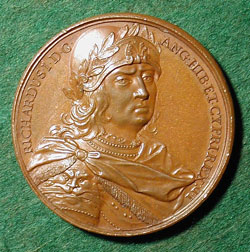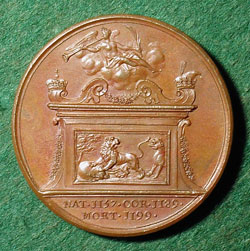

|
RICHARD I |
|
|
Richard I (The Lion Heart; Coeur de Lion) (1157-1199) was born in Chalus, Duchy of Aquitaine. He was the third son of Henry II and Eleanore of Aquitaine. Richard refused to cede Aquitaine to his youngest brother, John, and joined forces with Philip II Augustus of France to force Henry II into exile. He was the Duke of Aquitaine and of Poitiers before becoming King of England, Duke of Normandy, and Count of Anjou from 1189 to 1199. In 1189 Richard led the crusade against the great Muslim leader Saladin, who had captured Jerusalem in 1187. With money raised in England he amassed a formidable fleet and an army, and in 1190 he departed for the Holy Land. Richard conquered Cyprus and regained Acre and Joppa but failed to achieve his primary objective-- the recapture of Jerusalem. While in Cyprus, he married Berengaria of Navarre. During his return voyage to England, Richard was captured by Leopold V of Austria, who turned him over to Emperor Henry VI. Richard was released after paying a huge ransom. While Richard was in prison though, his brother John had conspired against him in England, and Philip II had invaded his territories in France. Richard was killed in battle and was succeeded by his brother John. (O’Brien) Richard’s knightly manner and his prowess in the Third Crusade (1189-1192) made him a popular king as well as the hero of countless romantic legends. |
|